IN THE ISSUE:
- Our Map of the Human-Scale City
- Real Estate Oligarch Larry Silverstein Buys Penthouse and Gets a 421a Tax Abatement?
- Overdevelopment in Flushing
- 15 Questions for Candidates to City Office
- Call-to-Action to save our Libraries
- A win for Gansevoort Market
- Health & High-Rise Living
- Despicable Real Estate Ad of the week: 15 Hudson Yards
- Overlooked Op-Eds of the Week on Public Space
- More Obscure, but Brilliant Jane Jacobs Quotes on Gentrification and Neighborhood Supply
OUR NEW MAP OF THE HUMAN-SCALE CITY
I bet most you think we have lost our human-scale city. With all the over-sized towers in Midtown and those arising in Hudson Yards, and with Trump Tower in the news every day, we understand why you may have thought that NYC only has skyscrapers. But wait, the majority of buildings in NYC are actually human-scaled! Yes, REBNY would like to knock them all down, but the truth is that we have plenty of human-scaled properties left that we need to protect and fight for.
Check out our new human-scale map below. The darker the red, the taller the building (the number of stories is indicated in the legend to the map). We are excited to see so many human-scale buildings under 16 stories remain, despite the large pockets of high-rises in midtown and lower Manhattan. A more interactive version of this map will soon be up on our website, one that includes the missing parts of the city.
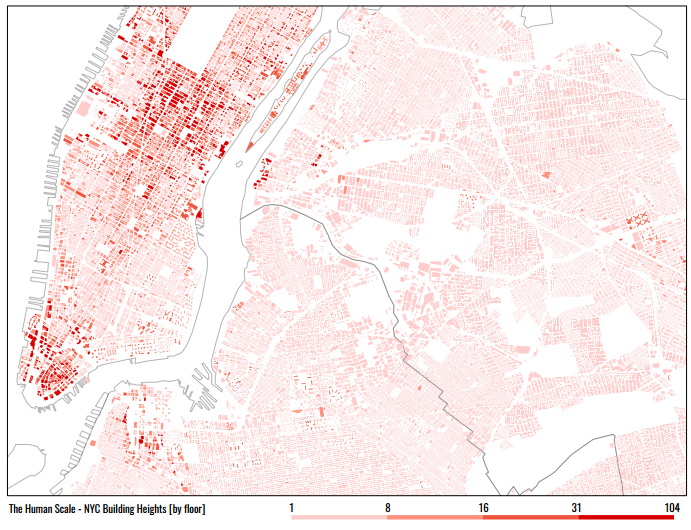
REAL ESTATE OLIGARCH LARRY SILVERSTEIN (Trump’s ‘friend’)- BUYS PENTHOUSE AND GETS 421-A TAX ABATEMENT – Really?
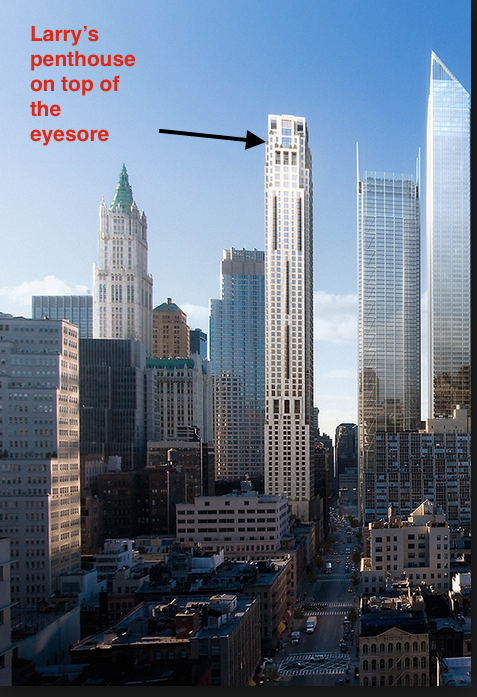
We learn from the Wall Street Journal (paywall here) that Larry Silverstein spent $34 million to buy the penthouse at the monstrous, soul-sucking, neighborhood destroying pile dubbed “30 Park Place.” You can get a hint of what it looks like here on Curbed. Here’s a terrace from the unit below Larry’s:
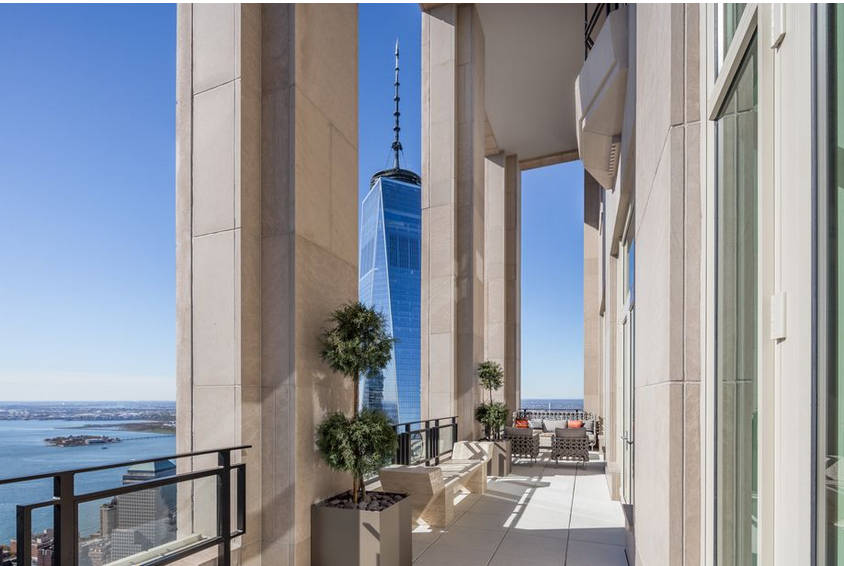
But wait, didn’t we learn from the New York Times (here) a couple of years ago that Silverstein and his REBNY friends contributed huge amounts of money to upstate Republican lawmakers so that the corrupt lawmakers would draft and pass a special bill in January of 2013 to allow 30 Park Place – and a few other supertalls – a 421a tax exemption? Yup. That’s right, we learned it from the Times.
So inquiring minds want to know: is Larry Silverstein, who used public subsidies to inflict this eyesore upon us, and who has palatial homes outside the city – and is, as the video below shows, a “friend of Trump” paying especially low real estate taxes on this penthouse because of 421-a tax abatements he obtained through “legal-only-in-corrupt-NYC” rules? Is this how the real estate oligarchs of our city get to rule? Why, oh, why, did Cuomo disband the Moreland Commission on Corruption which was investigating this issue?
Anyone who can find out what Larry’s taxes are for the penthouse at 30 park Place and the exact square footage of the penthouse wins a free subscription to this newsletter for life.
And if you didn’t believe that Silverstein was a friend of Trump, well, here is Trump proclaiming it in the video clip below. Why does it matter? Because it symbolizes how a creepy oligarchy works: an interconnected set of “friends” and real estate oligarchs ruling our city and telling our politicians what to do, from downtown to Midtown to Columbus Circle to Long Island City to East Harlem, to downtown Brooklyn, to Jerome Avenue in the Bronx. And now they’re in the White House.
If your browser won’t show the video below and all you get is a black screen, try this link instead.
Over-development in Flushing
You know the world is turned upside down when even developers cry over-development. Such is the case with Flushing, Queens, where Real Deal reports here that 2,600 new luxury condos have come onto the market since 2010 and that as many as 2,800 more are in the pipeline. Real Deal’s tagline: “With an over-taxed infrastructure and thousands of condos in the pipeline, can the Queens enclave sustain the housing boom? And even the head of the Business Improvement District “fretted that the major traffic congestion will discourage the very consumers the new developments are aiming to woo.”
Lesson? Real estate capital cannot regulate itself. We have to do it for them.
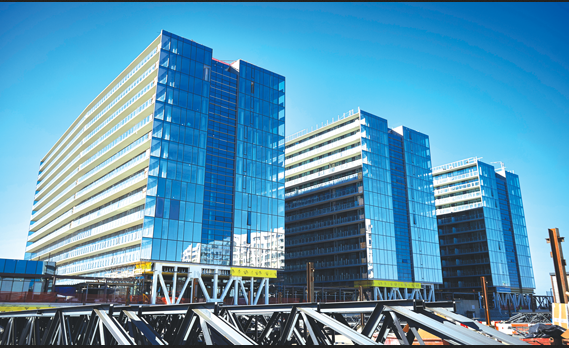
Skyview Park in Flushing
15 QUESTIONS FOR EVERYONE RUNNING FOR CITY OFFICE
For the 2017 election-season, the Alliance for a Human-scale City has developed a candidate questionnaire. It consists of 15 questions about the aspirant officeholder’s position on the built environment and neighborhood development. We will be giving the responders a “grade” that summarizes their position on the urban planning and real estate. Check out the survey questions here. We will keep you posted in mid-March about how the candidates respond.
SAVE OUR LIBRARIES: Action alert from Citizens Defending Libraries (CDL)
Citizens Defending Libraries (CDL) has issued an alert here about the new wave of library shrinkage plans. In play are: the Crown Heights Library, the Science, Industry and Business Library on 34th Street, and the Inwood Public Library. CDL notes that Manhattan Borough Gale Brewer has supported the sale of the Manhattan libraries, which seems a disturbing position for her to take, given how popular libraries are among her Manhattan constituents. CDL urges us all to call (or email or write) the Manhattan Borough President’s office and ask her to stiffen her spine against these bad deals for the public realm. Details below.
Many other libraries across the boroughs are also getting eyed for potential sales, so don’t get the notion that your small branch is somehow safe.
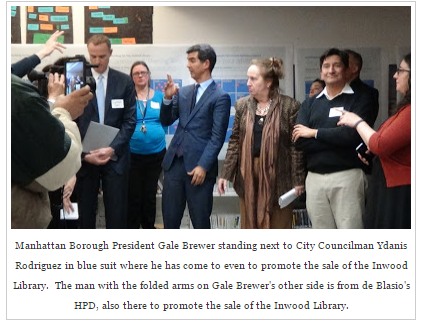
(Photo source: http://citizensdefendinglibraries.blogspot.com)
Here are the action alert instructions:
“Call Gale Brewer’s office starting as soon as you get this email.
Hello my name is ———, I am a library user and stand with Citizens Defending Libraries (CDL) in asking you to oppose the current unforgivable sale of important libraries owned and supported by our taxes. Please also ask our trustees to stop getting rid of our research books, especially the science research books that our climate scientists need to study global warming. Ask the NYPL to provide all documents that CDL has requested and FOILed.
CONTACT INFORMATION
Gale Brewer, Manhattan Borough President
(212) 669-8300
1 Centre St 19th Floor
New York NY 10007
Variants of the same messages for Gale and our elected officials:
Stand with the public not with the private predators
Stand up for books not for digital companies that want to get rid of physical books
Stand for climate research, not for making information less accessible
Stand for transparency and accountability not for NYPL secrecy
Stand for public good not for NYPL renting out our libraries for billionaire weddings
A WIN (so far) FOR THE GANSEVOORT MARKET
The recent legal proceedings for the Gansevoort Market case was covered by multiple media sources including Dna info here, Crain’s here, Politico here, and NY Curbed here.
Save Gansevoort is a local advocacy group that filed a lawsuit against New York City’s Landmarks Preservation Commission in October. The organization formed after a developer proposed a large-scale redevelopment on Gansevoort Street within the Historic District. The LPC approved the proposal, causing Save Gansevoort to take the issue to court.
We are intrigued to report that the state Supreme Court Justice, Judge Joan Lobis, granted a temporary restraining order to the developers, barring demolition or construction work. The next hearing is scheduled for March 8. The legal issues here have less to do with the usual human-scale issues we talk about there, and more to do with the functioning of the Landmarks Preservation Commission and they go to the very purpose of how the Landmarks Law should be interpreted. What for example, does “contextual” mean? Hence this is one of the more interesting cases to follow.

Buildings that would be demolished for new construction (Photo Source: crainsnewyork.com)
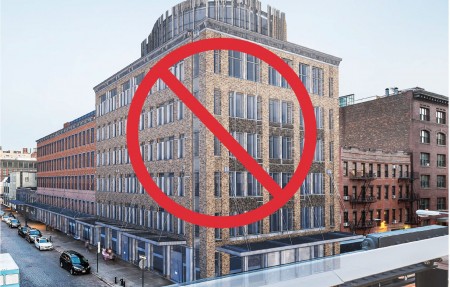
Rendering of new building (Photo Source: savegansevoort.org)
HEALTH & HIGH-RISE LIVING: Don’t get a heart attack if you live higher than the 16th Floor…..
6sqft covered this story here. The article reviews some studies about the health risks of living in high-rise buildings:
- Higher mortality rates: Caused to do slower emergency response times.
- Higher risk of mental health issues: Caused by people living in isolation and reduced access to street life.
Best quote is this one: In one widely cited study published in early 2016 in the “Canadian Medical Association Journal,” high-rise living was seen to radically decrease one’s chances of surviving a cardiac arrest. The study, which involved 7,842 cases of out-of-hospital cardiac arrest, concluded that survival was greater on lower floors than higher floors. Indeed, the study found that survival was 0.9 percent above floor sixteen and that there were no survivors above the twenty-fifth floor.”
While the article cites some benefits of living higher, such as better air quality, some studies also suggest that the only reason for those benefits is that typically wealthier tenants live on the higher floors.
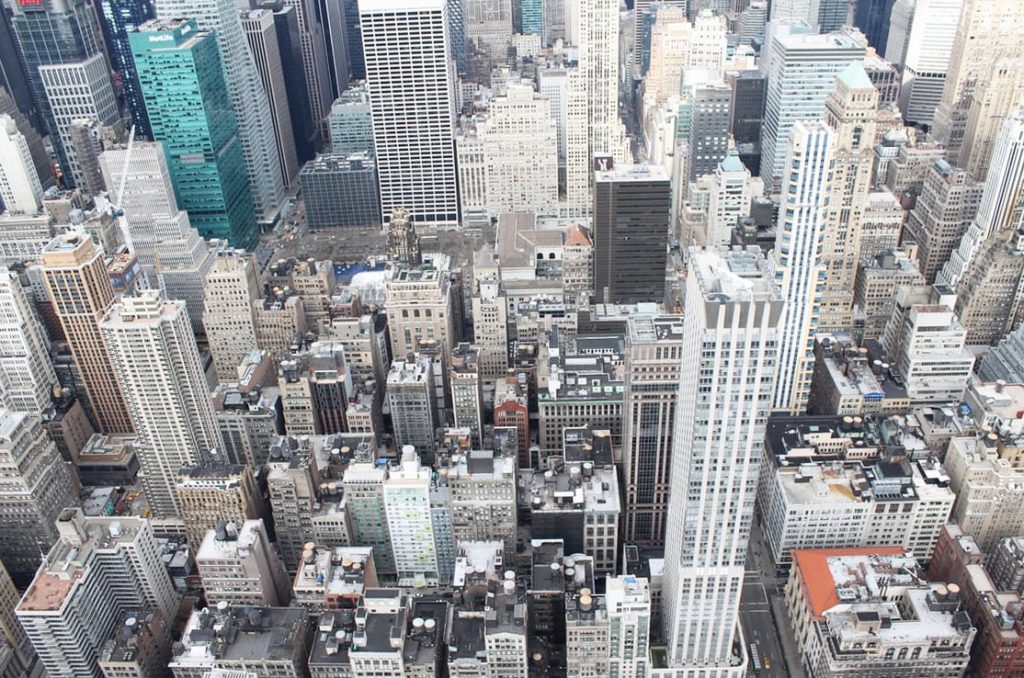
(Photo Source: 6sqft)
DESPICABLE REAL ESTATE AD OF THE WEEK: Classic Bait and Switch
Check out this ad we saw to promote 15 Hudson Yards. “Be inspired to come home” it says. Look twice. Where are we? Does anyone see New York City in this photo, or are we looking at some scary part of Miami, Florida? And what are we to make of the fake photoshopped family? The parents are wearing black and the girl carries the pink balloons? They are walking home or to a hotel? Hard to tell. And is the building in the background actually a rollercoaster at a theme park? And hey, is there any street level commerce in this corporate world of Hudson Yards? No. Of course not. But what is truly despicable is the attempt to create a human-scale “scene” to sell a despicable building that belongs in Dubai.
Don’t be fooled. There is nothing human-scale about Hudson Yards. Look at the second photo below to see what 15 Hudson Yard really looks like (with prices topping out at “over $30 million per unit) for the views of the Hudson. In the doing, check out the horrific streetscape that will really define the area. It is a nightmare world, not a human-scale world. Conclusion: hyper-density creates dead (and of necessity, photoshopped) neighborhoods, not great urbanity.

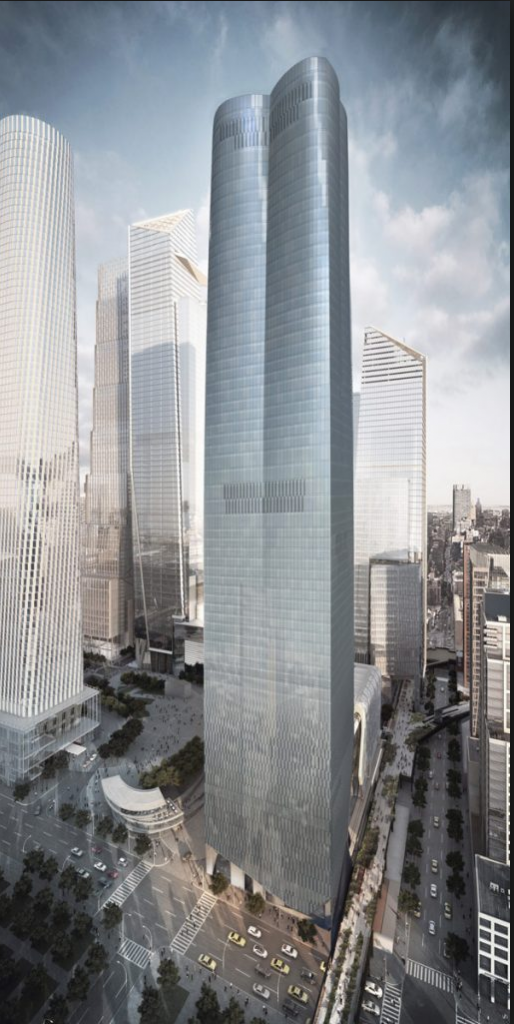
15 Hudson Yards
GREAT OVERLOOKED OP-EDS ON PUBLIC SPACES
Our interns found two Op-eds at the bottom of our clippings pile from last summer. Both are good enough to revive here.
- The first is a New York Times article that covered a Q&A with James Wines. You can read the interview here.
Mr. Wines is known for his radical art and architecture projects. In the interview, he laments the bad public spaces of New York. The best quote is this: ” I lived in Italy for a long time, and the thing I noticed the most in coming back from Europe is that those cities were conceived from the outset with the idea that there will be a public domain. New York evolved as an economic force on a grid and primarily for opportunism. It’s very difficult after the fact to take that paving grid view of the world and loosen it up” Our take: difficult but not impossible, what we lack is political will on part of our “done deal” elected officials.
Second best quote from the interview: “Those Renaissance and Baroque guys knew about the value of sunlight, creating light and shadow. Most public buildings, it just glances off the surface and that’s about it….Here, landscape is too contrived, it looks as cold and hard as the pavement itself.”

James Wines (Photo Source: nytimes.com)
2. The second op-ed came from Our Town, which you can find here.
This article discusses how a state appeals court put a temporary ban on what Our Town calls the “privatization of our public spaces”. The court ordered that the park getting built on Pier 55, which is privately funded, must stop after an environmental review. The community was not consulted, even though these are public lands.
The City Club of New York brought this case to court against the developers, but, alas, the case was dismissed. The park will definitely arise, with substantial design modifications that you can read about on Curbed New York here. But the best quote from the op-ed was this: “It is time our private park brigades stop ignoring communities – and treating our public spaces as another part of the city that is theirs to run.” Well put, editors!
Pier 55 Design (Photo Source: ny.curbed.com)
More Obscure-but-Brilliant Jane Jacobs Quote
It’s tricky being a fan of Jane Jacobs. Right-wing urbanists and haters of the distinctive city also claim Jane Jacob’s mantle. My take on her was she was an activist to the core and belongs to us, to we who are neighborhood residents here in NYC. She belongs to us more than to the urban planners [none of whom appear to actually work in our Department of City Planning] who claim her as their own. Into that forever-unresolvable debate someone sent me a little kindle book, “Jane Jacobs: The Last Interview” and Other Conversations.” I pounced on it and discovered a charming interview with Jane by the ever-brilliant urbanist, James Howard Kunstler, whose own book, “The Geography of Nowhere” ranks right up there with Death and Life as one of the greatest books about urban development in the past 60 years. The Interview was originally published in Metropolis in 2001.
Here are my favorite quotes:
“It was the Rockefellers that wanted to knock it [West Village] down…..That was really where it started, in the Downtown Lower Manhattan Association, which was David Rockefeller’s organization…..There were all these essentially private visions of how beautiful the city would be and it was to be all these high-rises.”
“There is no new world that you make without the old world. …The notion that you could discard the old world and now make a new one. This is what was so bad about Modernism.”
“There are too few [good] neighborhoods right now, so the supply doesn’t nearly meet the demand. So they [existing good neighborhoods] are just gentrifying in the most ridiculous way. They are crowding out everybody except people with exorbitant amounts of money. Which is a symptom that demand for such a neighborhood has far outstripped supply.”
Do you hear that, Mayor De Blasio and Edward Glaeser? It’s about neighborhood supply, not housing unit supply.

/cdn0.vox-cdn.com/uploads/chorus_asset/file/7895641/Pier55__site_view_high_res.jpg)
